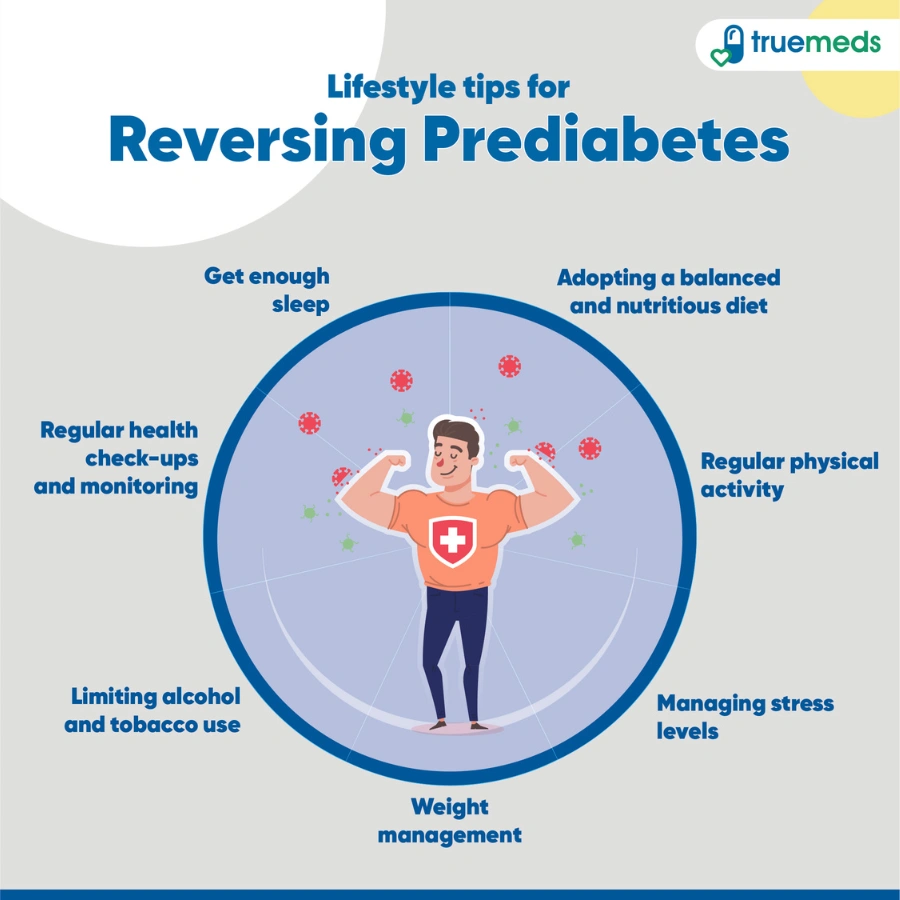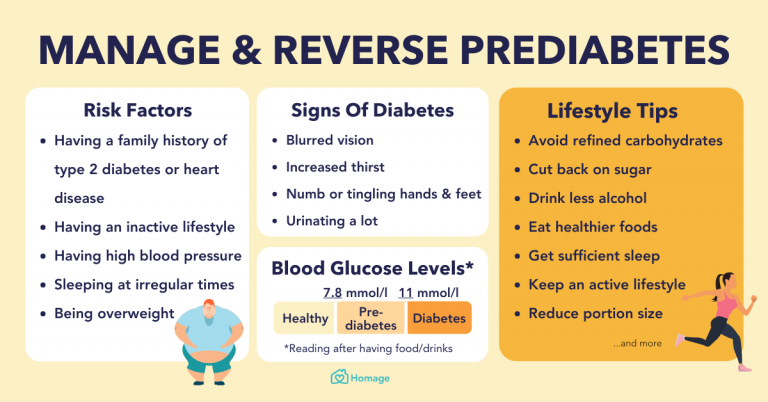The Impact of Lifestyle Choices on Prediabetes Reversal

Exploring the pivotal role of lifestyle in reversing prediabetes opens up a world of possibilities for individuals looking to take charge of their health. From dietary adjustments to exercise routines, this topic delves into the transformative power of lifestyle changes in combating prediabetes.
Dive deeper into the factors influencing prediabetes development and discover practical strategies for a healthier future.
Lifestyle Factors Impacting Prediabetes
Leading a sedentary lifestyle and making poor dietary choices are key factors that contribute to the development of prediabetes. These lifestyle habits can lead to weight gain, insulin resistance, and elevated blood sugar levels, putting individuals at higher risk for developing type 2 diabetes.
In order to reverse prediabetes, it is essential to address these lifestyle factors and make positive changes.
Role of Diet in Prediabetes
A diet high in refined sugars, unhealthy fats, and processed foods can exacerbate prediabetes by causing spikes in blood sugar levels and promoting inflammation. On the other hand, a balanced diet rich in whole foods, fiber, and lean proteins can help stabilize blood sugar levels and improve insulin sensitivity.
Making dietary changes such as reducing sugar intake, increasing fiber consumption, and choosing nutrient-dense foods can play a significant role in reversing prediabetes.
Impact of Physical Activity
Physical activity plays a crucial role in the management and reversal of prediabetes. Regular exercise helps lower blood sugar levels, improve insulin sensitivity, and aid in weight loss. Both aerobic exercises, such as walking, jogging, or cycling, and strength training can be beneficial for individuals with prediabetes.
Increasing physical activity levels and incorporating exercise into daily routines can have a positive impact on overall health and help prevent the progression to type 2 diabetes.
Stress Management and Sleep Quality
Chronic stress and poor sleep quality can contribute to the development and progression of prediabetes. Stress hormones like cortisol can increase blood sugar levels, while inadequate sleep can disrupt hormone balance and metabolism. Implementing stress management techniques such as mindfulness, meditation, and relaxation exercises can help lower stress levels and improve insulin sensitivity.
Additionally, prioritizing good sleep hygiene practices like maintaining a consistent sleep schedule and creating a relaxing bedtime routine can support overall health and aid in prediabetes reversal.
Implementing Dietary Changes
Implementing dietary changes is crucial in managing prediabetes and improving overall health. One of the key aspects of a prediabetes-friendly diet is designing a balanced meal plan that focuses on nutrient-dense foods and controlled portions.
Designing a Balanced Meal Plan
- Include a variety of fruits, vegetables, whole grains, lean proteins, and healthy fats in your meals.
- Aim for a balanced plate with half filled with non-starchy vegetables, a quarter with lean protein, and a quarter with whole grains or starchy vegetables.
- Avoid processed foods, sugary beverages, and excessive amounts of refined carbohydrates.
Importance of Portion Control and Meal Timing
- Practice portion control by using smaller plates, measuring portions, and being mindful of serving sizes.
- Eat regular meals and snacks throughout the day to maintain stable blood sugar levels.
- Avoid skipping meals or going long periods without eating to prevent spikes and crashes in blood sugar.
Food Choices to Include and Avoid
- Include foods like leafy greens, berries, nuts, seeds, fish, and whole grains that are rich in nutrients and fiber to help manage blood sugar.
- Avoid sugary snacks, desserts, processed meats, and high-fat fried foods that can contribute to insulin resistance and elevated blood sugar levels.
Tips for Dining Out
- Choose restaurants that offer healthier options like salads, grilled proteins, and steamed vegetables.
- Ask for dressings and sauces on the side to control portion sizes and reduce hidden sugars and fats.
- Opt for water or unsweetened beverages instead of sugary drinks, and limit alcohol consumption to manage blood sugar levels effectively.
Physical Activity and Exercise

Regular physical activity and exercise play a crucial role in managing and reversing prediabetes. It helps improve insulin sensitivity, manage weight, and reduce the risk of developing type 2 diabetes. Different types of exercises are suitable for individuals with prediabetes, each offering unique benefits.
Types of Exercises for Prediabetes
When it comes to prediabetes, a combination of aerobic exercise and strength training is highly recommended. Aerobic exercises such as brisk walking, cycling, swimming, or dancing help improve cardiovascular health and burn calories
Benefits of Aerobic Exercise vs. Strength Training
While aerobic exercise primarily focuses on improving cardiovascular health and burning calories, strength training helps build muscle mass, which can increase metabolism and improve insulin sensitivity. Both types of exercises are essential for overall health and can contribute to reversing prediabetes when done consistently.
Frequency and Duration of Physical Activity
For individuals with prediabetes, it is recommended to engage in at least 150 minutes of moderate-intensity aerobic exercise per week, spread out over several days. Strength training exercises should be performed at least two days a week, targeting major muscle groups.
Consistency is key to seeing improvements in insulin sensitivity and overall health.
Incorporating Movement into Daily Routines
There are creative ways to incorporate more movement into daily routines for prediabetic individuals. This can include taking the stairs instead of the elevator, parking farther away from the entrance, doing household chores actively, or using a standing desk at work.
Small changes can add up and contribute to overall physical activity levels.
Stress Management and Sleep Hygiene

Stress and poor sleep can significantly impact the risk of developing prediabetes. Managing stress effectively and maintaining good sleep hygiene are crucial components in reversing prediabetes and improving overall health.
Strategies for Stress Reduction
- Practice mindfulness meditation or deep breathing exercises to reduce stress levels.
- Engage in regular physical activity, such as yoga or walking, to relieve stress and improve mood.
- Schedule regular breaks throughout the day to rest and recharge, avoiding burnout.
Establishing a Healthy Sleep Routine
- Set a consistent sleep schedule, going to bed and waking up at the same time every day.
- Create a relaxing bedtime routine, such as taking a warm bath or reading a book, to signal the body that it's time to sleep.
- Avoid screens and stimulating activities before bedtime to promote better sleep quality.
Relaxation Techniques for Better Sleep
- Practice progressive muscle relaxation to release tension in the body before sleep.
- Use calming essential oils like lavender or chamomile to create a soothing environment for sleep.
- Try guided imagery or visualization exercises to calm the mind and prepare for restful sleep.
Final Conclusion

In conclusion, embracing a lifestyle focused on healthy choices and mindful habits can be the key to reversing prediabetes and improving overall well-being. By incorporating these insights into daily life, individuals can embark on a journey towards better health and vitality.
FAQ Corner
What are the key lifestyle factors contributing to prediabetes?
Key lifestyle factors include diet, physical activity levels, stress management, and sleep quality.
How can portion control and meal timing help manage blood sugar levels in prediabetes?
Portion control and meal timing play a crucial role in regulating blood sugar levels by preventing spikes and crashes.
What are some examples of foods to include in a prediabetes-friendly diet?
Examples include whole grains, lean proteins, fruits, vegetables, and foods low in added sugars and unhealthy fats.
How can stress reduction techniques aid in reversing prediabetes?
Reducing stress can help lower cortisol levels, improve insulin sensitivity, and positively impact blood sugar regulation.
What are creative ways to incorporate more movement into daily routines for prediabetic individuals?
Simple strategies like taking the stairs, walking during breaks, and engaging in active hobbies can boost daily physical activity levels.

